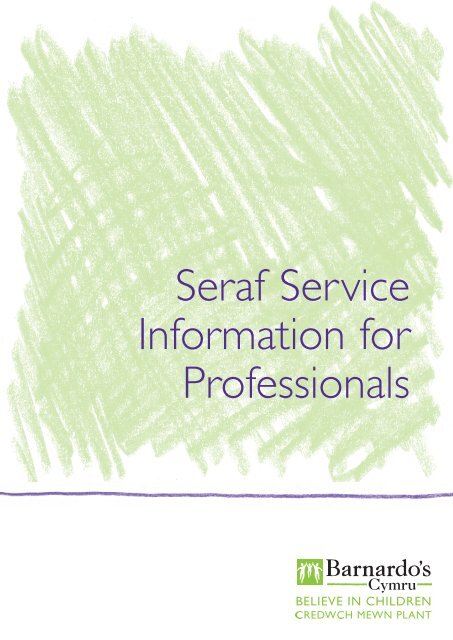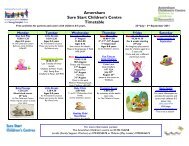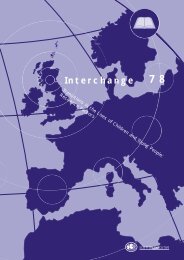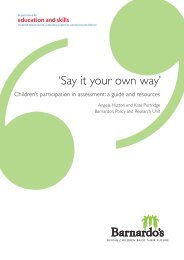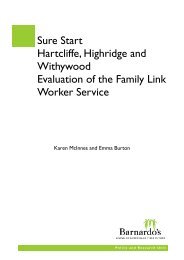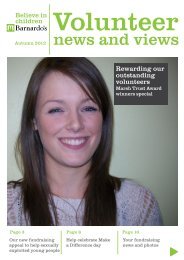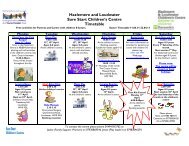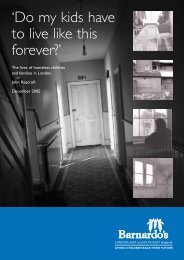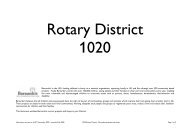Seraf Service Information for Professionals - Barnardo's
Seraf Service Information for Professionals - Barnardo's
Seraf Service Information for Professionals - Barnardo's
Create successful ePaper yourself
Turn your PDF publications into a flip-book with our unique Google optimized e-Paper software.
<strong>Seraf</strong> <strong>Service</strong><br />
<strong>In<strong>for</strong>mation</strong> <strong>for</strong><br />
<strong>Professionals</strong>
Contact Us<br />
Barnardo’s Cymru <strong>Seraf</strong> <strong>Service</strong><br />
Tel: 029 2049 1743<br />
Email: <strong>Seraf</strong><strong>Service</strong>@barnardos.org.uk<br />
<strong>Barnardo's</strong> Registered Charity Nos 216250 and SC037605<br />
9298/CD/07
What is the <strong>Seraf</strong> <strong>Service</strong>?<br />
Barnardo’s Cymru launched the <strong>Seraf</strong> <strong>Service</strong> in October 2006, a new service to work with children and<br />
young people who are at risk of or abused through sexual exploitation in Wales.<br />
The <strong>Seraf</strong> <strong>Service</strong> is the only of its kind in Wales, and followed two years of research and campaign work by<br />
Barnardo’s Cymru to highlight the level of need in Wales and the lack of support services.<br />
<strong>Seraf</strong> has bases in North, South and West Wales providing support to those who are being sexually exploited<br />
across Wales.<br />
The <strong>Seraf</strong> <strong>Service</strong> is also working in partnership with Welsh Assembly Government and local authorities to<br />
promote better understanding of the systems needed to protect at risk children and young people, and to<br />
expand support services.<br />
<strong>Seraf</strong> <strong>Service</strong> Aim<br />
Children and young people are safe from abuse through sexual exploitation<br />
<strong>Seraf</strong> <strong>Service</strong> works to achieve a set of outcomes <strong>for</strong> children and young people<br />
Child or young person is in regular contact with the service and able to accept support (WAG Core Aim 5).<br />
Child or young person has a suitable place to live, with care and support adequate to their needs<br />
(WAG Core Aim 6).<br />
Child or young person does not go missing from home/care (WAG Core Aim 6).<br />
Child or young person has reduced conflict with parents or carers (WAG Core Aim 6).<br />
Child or young person does not associate with controlling/risky adults (WAG Core Aim 3).<br />
Child or young person does not associate with peers involved in sexual exploitation (WAG Core Aim 3).<br />
Child or young person attends education/training/work (WAG Core Aim 2).<br />
Child or young person is aware of sexual health risks and protects themselves appropriately<br />
(WAG Core Aims 2 and 3).<br />
Child or young person does not have problematic drug/alcohol use (WAG Core Aim 3).<br />
Child or young person does not experience violence (WAG Core Aim 3).<br />
Child or young person is able to recognise risky and exploitative relationships and to assert their rights in<br />
relationships (WAG Core Aim 2).<br />
Child or young person is safe from abuse (WAG Core Aim 3).<br />
Child or young person has a consistent positive relationship with at least one nuturing adult<br />
(WAG Core Aims 5 and 6).<br />
Child or young person has their health needs met (WAG Core Aim 3).<br />
Child or young person has opportunities to enjoy a range of activities and has the confidence to<br />
participate (WAG Core Aims 2 and 4).<br />
Child or young person has a range of independent living skills (WAG Core Aim 2).<br />
Child or young person engages in law abiding, positive behaviours (WAG Core Aim 2).<br />
Child or young person has a reduced SERAF score (WAG Core Aim 3).
What is Child Sexual Exploitation?<br />
The sexual exploitation of children and young people is a hidden <strong>for</strong>m of abuse and as such it is difficult to<br />
define. A number of different definitions have been developed through the work of researchers and<br />
practitioners though the concepts of exploitation and exchange are central to each.The varying ways in which<br />
abuse through sexual exploitation manifests itself are captured in the following definition:<br />
A <strong>for</strong>m of sexual abuse ‘rationalised by the concept of exchange it is specifically exploitation of young men and<br />
young women where they have needs that would compromise their ability to provide any <strong>for</strong>m of in<strong>for</strong>med consent<br />
to [sexual] activity. Exchange can be used to describe both tangible (money, drink, drugs) and intangible (shelter,<br />
protection, coercion) <strong>for</strong>ms of payment’<br />
(Manchester ACPC, cited in Calder 2001)<br />
What is Barnardo’s Cymru doing to address CSE in Wales?<br />
In 2005 Barnardo’s Cymru carried out a scoping study in Wales, culminating in the Out of sight, out of mind<br />
report 1 which identified at least 180 children and young people in Wales who were known to be sexually<br />
exploited, or at risk of being sexually exploited.This was believed to be a real underestimation of the numbers<br />
of children involved and a study undertaken in 2006 2 which looked at over 350 cases on one local authority’s<br />
Children’s <strong>Service</strong>s caseloads identified 121 children as being at moderate or significant risk of sexual<br />
exploitation.The findings of the pilot study have helped to establish a picture of local prevalence and of<br />
dominant vulnerability and risk indicators. It provides us with the first detailed picture of the nature of sexual<br />
exploitation in a Welsh local authority.<br />
SERAF Resource Pack<br />
The 2006 study provided the opportunity to develop and pilot a risk assessment framework (SERAF). SERAF<br />
<strong>for</strong>ms part of an in<strong>for</strong>mation and intervention pathway <strong>for</strong> safeguarding children and young people.The risk<br />
assessment tool and in<strong>for</strong>mation and intervention pathway have been developed by Barnardo’s Cymru in<br />
response to issues raised by practitioners in relation to difficulties in identification and intervention with<br />
children and young people at risk of or abused through sexual exploitation.The SERAF resource pack is<br />
designed to support best practice in responding to child sexual exploitation so that local authorities, partner<br />
agencies and practitioners can:<br />
Identify children and young people at risk of or abused through sexual exploitation;<br />
Manage in<strong>for</strong>mation about children and young people in a way that identifies risk, gathers intelligence and<br />
monitors the extent of the issue locally;<br />
Identify appropriate interventions and safeguarding actions <strong>for</strong> children and young people at risk of child<br />
sexual exploitation;<br />
Deliver evidence based best practice in responding to the needs of children and young people at risk of<br />
or abused through sexual exploitation.<br />
The SERAF Resource Pack can be purchased from the <strong>Seraf</strong> <strong>Service</strong>.<br />
1 Coles, J (2005) Out of sight, out of mind: Child sexual exploitation. Barnardo’s Cymru, Cardiff.<br />
2 Clutton, S and Coles, J (2006) Sexual Exploitation Risk Assessment Framework: a pilot study. Barnardo’s Cymru, Cardiff.
The <strong>Seraf</strong> <strong>Service</strong> offers a range of services<br />
1. Intensive Support Programme<br />
Intensive Support Programme with Children and Young People aged 10 to 18 who are at risk of or abused<br />
through sexual exploitation.<br />
Model of Practice<br />
Barnardo’s has been involved in child sexual exploitation work since 1995.The core features of our model of<br />
practice can be summarised in the Four A’s of Access, Attention, Assertive outreach and Advocacy. 3 Evidence<br />
of good practice suggests that intervention, support and action should be based upon the child or young<br />
person’s needs and be delivered by a trusted worker in conjunction with a protective network of appropriate<br />
agencies.<br />
Level and Duration<br />
The presence of multiple vulnerabilities and risks in the lives of children and young people at significant risk of<br />
sexual exploitation often means that they are described by professionals as ‘difficult to engage’. By the point in<br />
a child or young person’s life where they are significantly at risk of or are already abused through sexual<br />
exploitation they are subject to a complex pattern of life experiences which impact negatively on each<br />
dimension of their life. Evidence from research and practice identifies that a key feature of successful work with<br />
children and young people at risk of or abused through sexual exploitation is its long term nature.This support<br />
programme is offered <strong>for</strong> no less than 12 months.<br />
What We Offer<br />
An initial SERAF assessment based on in<strong>for</strong>mation known to agencies such as children’s services will be made<br />
within the first 2 weeks. A more detailed assessment of risk and need will be made over the first 6 months<br />
with an interim report at the 3 month stage.<br />
Initially the practitioner will focus on building a positive relationship with the child or young person. This will<br />
involve at least weekly direct work sessions. The sessions will centre on activities based on the child’s own<br />
interests.<br />
The length of time taken to establish a positive working relationship depends on each individual child’s<br />
circumstances and the timescales are there<strong>for</strong>e approximate. <strong>Seraf</strong> practitioners make a significant investment<br />
of time using a range of techniques to encourage and enable children and young people to engage with the<br />
service.<br />
Once a positive relationship has been established the work plan will include a mix of activities and issue-based<br />
work aimed at addressing the risks and needs identified through the assessment.<br />
The work will be reviewed at least every 12 weeks.<br />
The assessment and work will identify an overall level of risk in relation to sexual exploitation, factors which<br />
present specific risk to the young person and recommendations <strong>for</strong> how risks can be addressed and protective<br />
factors increased.<br />
3 Scott, S and Skidmore, P (2006) Reducing the risk: Barnardo’s support <strong>for</strong> sexually exploited young people: A two-year evaluation,<br />
pp48-49. Barnardo’s, Barkingside.
Sharing <strong>In<strong>for</strong>mation</strong><br />
It is crucial that time is taken to establish a positive, trusting relationship between young people and their <strong>Seraf</strong><br />
workers in order <strong>for</strong> accurate in<strong>for</strong>mation to be gathered. In order to support this relationship and promote<br />
trust the details of sessions will remain confidential to the <strong>Seraf</strong> <strong>Service</strong>, whilst in<strong>for</strong>mation relevant to<br />
safeguarding and protection will always be shared.<br />
Barnardo’s <strong>Seraf</strong> <strong>Service</strong> has a written confidentiality statement given to young people that says:<br />
“We will not discuss your circumstances or give out in<strong>for</strong>mation about you to anyone outside of <strong>Seraf</strong> <strong>Service</strong> unless<br />
you give your permission and agree what is being said. However, there may be times, like if we find out that you or<br />
any one else is in a life-threatening situation or that you are a danger to yourself or others, when we will need to<br />
pass in<strong>for</strong>mation on to others.”<br />
Objectives of the intensive support programme are to enable a child or young person to:<br />
Develop a relationship of trust with a protective adult<br />
Break from harmful, abusive and exploitative relationships<br />
Increase his/her ability to recognise risky and exploitative relationships<br />
Increase his/her ability to assert her/his rights<br />
Increase awareness around the risks of her/his behaviour (e.g. going missing)<br />
Make in<strong>for</strong>med choices<br />
Improve own safety through the provision of ongoing support<br />
Enjoy improved self-esteem<br />
Support will be delivered in a supportive, confidential and young person focussed environment<br />
The intensive support will be provided by a practitioner who will:<br />
Engage in assertive outreach to develop and maintain a positive and meaningful relationship with the child<br />
or young person<br />
Undertake an assessment of risk and need in relation to sexual exploitation<br />
Develop a personalised work plan in conjunction with the individual child or young person<br />
Take part in activities with the child or young person based on particular, individual interests<br />
Deliver one-to-one sessions covering self-esteem, personal safety, recognising harmful and healthy<br />
relationships, risk-taking behaviours, protective behaviours, etc, in line with the individual work plan<br />
Support the child or young person in accessing appropriate services such as sexual health, counselling and<br />
safe accommodation<br />
Offer specialist advice, support, and consultation services to colleagues in other agencies<br />
Work with colleagues from multi-agencies to promote a co-ordinated and integrated service response to<br />
the needs of the child or young person
2. Group work programmes<br />
Targeted awareness raising interventions are delivered to groups of children and young people such as looked<br />
after children, care leavers and children outside of mainstream education, in the <strong>for</strong>m of group work sessions<br />
facilitated by a <strong>Seraf</strong> practitioner.<br />
Sessions can be tailored and delivered taking into account the individual needs of the group<br />
Delivered typically as a six week programme covering areas such as recognising risks; the grooming<br />
process; power, coercion, manipulation and abuse in relationships; routes and reasons into sexual<br />
exploitation; risk taking behaviour and identifying safety strategies.<br />
3. Preventive work in schools<br />
These sessions are designed to fit into schools’ PHSE programmes and are delivered by qualified practitioners<br />
in the classroom setting.Their aim is to educate children and young people in relation to potential risk<br />
situations in order <strong>for</strong> them to keep themselves safe.<br />
4.Training <strong>for</strong> professionals from multi agencies<br />
Level 1 – Safeguarding Children and Young People at Risk of Sexual Exploitation<br />
Learning objectives <strong>for</strong> training are tailored to the specific needs of the course participants. Learning objectives<br />
<strong>for</strong> a typical course would be to enable participants to:<br />
Gain a greater understanding of child sexual exploitation including definitions, triangles of abuse and<br />
processes of control<br />
Gain a greater understanding of the impact of this <strong>for</strong>m of abuse on children and young people<br />
Understand the context of CSE in Wales<br />
Explore professional assumptions of sexually exploited children and young people<br />
Explore practice issues and complexities relating to working with sexually exploited children<br />
Identify risk and vulnerability indicators <strong>for</strong> children and young people at risk of CSE drawing on best<br />
practice and research<br />
Gain a greater understanding of Government guidance and the responsibilities of their agencies to<br />
sexually exploited children<br />
Consider the needs of sexually exploited children and young people drawing on messages from research<br />
and how this can in<strong>for</strong>m an appropriate response.
Level 2 – Direct work skills: <strong>for</strong> those working with children and young people who may be<br />
vulnerable to abuse through sexual exploitation<br />
Again, learning objectives <strong>for</strong> training are tailored to the specific needs of course participants. Learning<br />
objectives <strong>for</strong> a typical course would be to enable participants to:<br />
Increase knowledge of best practice models <strong>for</strong> engagement and intervention with children and young<br />
people at risk of or abused through sexual exploitation<br />
Explore practice issues and complexities relating to working with sexually exploited children<br />
Explore methods and tools <strong>for</strong> use in direct work – both group and individual work<br />
Understand the SERAF (sexual exploitation risk assessment framework)<br />
Work within a risk assessment framework to assess and meet the needs of children and young people<br />
Explore the need <strong>for</strong> a multi-agency approach<br />
5. Consultation regarding specific cases<br />
Where colleagues have concerns that a child or young person with whom they work may be at risk of sexual<br />
exploitation, <strong>Seraf</strong> practitioners can offer consultation and advice regarding assessment of risk and need and<br />
interventions to meet need and protect.<br />
Practitioners are available to attend strategy/professionals meetings in relation to children at risk of or abused<br />
through sexual exploitation.<br />
Funding and Costs<br />
For details regarding spot purchase or service level agreements please contact the Children’s <strong>Service</strong> Manager,<br />
Jan Coles.<br />
For training request <strong>for</strong>ms and details of costs please contact the <strong>Service</strong> Administrator.<br />
To purchase a SERAF Resource Pack please contact the <strong>Service</strong> Administrator.<br />
Contact Us<br />
Barnardo’s Cymru <strong>Seraf</strong> <strong>Service</strong><br />
Tel: 029 2049 1743<br />
Email: <strong>Seraf</strong><strong>Service</strong>@barnardos.org.uk<br />
If you would like to discuss a particular case where you are concerned that a child may be at risk of sexual<br />
exploitation, please call 029 20491743 or email <strong>Seraf</strong><strong>Service</strong>@barnardos.org.uk<br />
More <strong>In<strong>for</strong>mation</strong><br />
Please visit www.barnardos.org.uk to download copies of:<br />
SERAF Sexual Exploitation Risk Assessment Framework: a pilot study (Clutton and Coles, 2007)<br />
Reducing the risk: Barnardo’s support <strong>for</strong> sexually exploited young people: A two-year evaluation (Scott and<br />
Skidmore, 2006)<br />
Out of sight, out of mind: Child sexual exploitation (Coles, 2005)
Gwasanaeth <strong>Seraf</strong><br />
Gwybodaeth i<br />
Weithwyr Proffesiynol
Cysylltu â Ni<br />
Gwasanaeth <strong>Seraf</strong> Barnardo’s Cymru<br />
Ffôn: 029 2049 1743<br />
E-bost: <strong>Seraf</strong><strong>Service</strong>@barnardos.org.uk<br />
Rhifau Cofrestru’r Elusen Barnardo’s 216250 a SC037605<br />
9298/CD/07
Beth yw'r Gwasanaeth <strong>Seraf</strong>?<br />
Lansiodd Barnardo’s Cymru y Gwasanaeth <strong>Seraf</strong> ym mis Hydref 2006, sef gwasanaeth newydd i weithio â<br />
phlant a phobl ifanc sydd naill ai mewn perygl o gael eu cam-drin drwy gamfanteisio rhywiol neu sy’n dioddef<br />
hynny ar hyn o bryd yng Nghymru.<br />
Gwasanaeth <strong>Seraf</strong> yw’r unig un o’i fath yng Nghymru, a daw yn sgil dwy flynedd o waith ymchwil ac ymgyrchu<br />
gan <strong>Barnardo's</strong> Cymru, er mwyn amlygu lefel yr angen yng Nghymru a'r diffyg gwasanaethau cefnogi.<br />
Mae gan <strong>Seraf</strong> leoliadau yng Ngogledd, De a Gorllewin Cymru, sy'n darparu cefnogaeth ledled Cymru i’r rheini<br />
y camfanteisir yn rhywiol arnynt.<br />
Mae'r Gwasanaeth <strong>Seraf</strong> hefyd yn gweithio mewn partneriaeth â Llywodraeth Cynulliad Cymru ac<br />
awdurdodau lleol er mwyn hybu gwell dealltwriaeth o'r systemau sy'n angenrheidiol i amddiffyn plant a phobl<br />
ifanc sydd mewn perygl, ac er mwyn ehangu gwasanaethau cefnogi.<br />
Nod Gwasanaeth <strong>Seraf</strong><br />
Bod plant a phobl ifanc yn ddiogel rhag camdriniaeth drwy gamfanteisio rhywiol<br />
Mae Gwasanaeth <strong>Seraf</strong> yn gweithio i gyflawni cyfres o ganlyniadau i blant a phobl ifanc<br />
Bod y plentyn neu’r person ifanc mewn cysylltiad rheolaidd â’r gwasanaeth ac yn gallu derbyn cymorth<br />
(Nod Craidd 5 LlCC).<br />
Bod gan y plentyn neu’r person ifanc le addas i fyw ynddo, gyda gofal a chymorth sy’n ddigonol i’w<br />
anghenion (Nod Craidd 6 LlCC).<br />
Nad yw’r plentyn neu’r person ifanc yn mynd ar goll o’i gartref/o ofal (Nod Craidd 6 LlCC).<br />
Bod y plentyn neu’r person ifanc yn gwrthdaro llai â’i rieni neu ofalwyr (Nod Craidd 6 LlCC).<br />
Nad yw’r plentyn neu’r person ifanc yn cymysgu ag oedolion rheolgar/peryglus (Nod Craidd 3 LlCC).<br />
Nad yw’r plentyn neu’r person ifanc yn cymysgu â chyfoedion sy’n ymwneud â chamfanteisio rhywiol<br />
(Nod Craidd 3 LlCC).<br />
Bod y plentyn neu’r person ifanc yn mynychu addysg/hyf<strong>for</strong>ddiant/gwaith (Nod Craidd 2 LlCC).<br />
Bod y plentyn neu’r person ifanc yn ymwybodol o beryglon iechyd rhywiol a’i fod yn amddiffyn ei hun yn<br />
briodol (Nodau Craidd 2 a 3 LlCC).<br />
Nad oes gan y plentyn neu’r person ifanc broblemau o ran defnyddio cyffuriau/alcohol (Nod Craidd 3 LlCC).<br />
Nad yw’r plentyn neu’r person ifanc yn wynebu trais (Nod Craidd 3 LlCC).<br />
Bod y plentyn neu’r person ifanc yn gallu adnabod perthynas beryglus a chamfanteisiol a mynnu ei hawliau<br />
mewn perthynas (Nod Craidd 2 LlCC).<br />
Bod y plentyn neu’r person ifanc yn ddiogel rhag camdriniaeth (Nod Craidd 3 LlCC).<br />
Bod gan y plentyn neu'r person ifanc berthynas gadarnhaol gyson gydag o leiaf un oedolyn cefnogol (Nod<br />
Craidd 5 a 6 LlCC).<br />
Bod anghenion iechyd y plentyn neu'r person ifanc yn cael eu diwallu (Nod Craidd 3 LlCC).<br />
Bod gan y plentyn neu’r person ifanc gyfleoedd i fwynhau amrywiaeth o weithgareddau a bod ganddo’r<br />
hyder i gymryd rhan (Nod Craidd 2 a 4 LlCC).<br />
Bod gan y plentyn neu’r person ifanc ystod o sgiliau byw’n annibynnol (Nod Craidd 2 LlCC).<br />
Bod y plentyn neu’r person ifanc yn ymddwyn yn gadarnhaol ac yn ufuddhau i’r gyfraith (Nod Craidd 2 LlCC).<br />
Bod sgôr SERAF y plentyn neu’r person ifanc wedi gostwng (Nod Craidd 3 LlCC).
Beth yw Camfanteisio ar Blentyn yn Rhywiol?<br />
Mae camfanteisio’n rhywiol ar blant a phobl ifanc yn fath cudd o gam-drin ac o’r herwydd mae’n anodd i’w<br />
ddiffinio. Mae nifer o ddiffiniadau gwahanol wedi cael eu datblygu drwy waith ymchwilwyr ac ymarferwyr er<br />
bod y cysyniad o gamfanteisio a chyfnewid yn ganolog i bob un. Mae’r gwahanol ffyrdd y mae cam-drin drwy<br />
gamfanteisio’n rhywiol yn amlygu ei hun yn cael eu crisialu yn y diffiniad canlynol:<br />
Ffurf ar gamfanteisio rhywiol a gaiff ei rhesymoli gan gysyniad cyfnewid; yn benodol, camfanteisio ar ddynion ifanc a<br />
merched ifanc ag anghenion a fyddai’n amharu ar eu gallu i roi unrhyw ffurf ar gydsyniad gwybodus i weithgaredd<br />
rhywiol. Gall cyfnewid ddisgrifio taliadau diriaethol (arian, diod, cyffuriau) ac anniriaethol (lloches, gwarchodaeth,<br />
gorfodaeth)<br />
(PAAP Manceinion, dyfynnwyd yn Calder 2001)<br />
Beth mae <strong>Barnardo's</strong> Cymru yn ei wneud i roi sylw i gamfanteisio’n rhywiol ar blant yng Nghymru?<br />
Yn 2005, cyflawnodd Barnardo’s Cymru astudiaeth gwmpasu yng Nghymru, a arweiniodd at yr adroddiad O'r<br />
golwg, o'r f<strong>for</strong>dd 1 , a oedd yn nodi o leiaf 180 o blant a phobl ifanc yng Nghymru y gwyddys y camfanteisir yn<br />
rhywiol arnynt, neu a oedd mewn perygl o hynny. Credid bod hyn yn amcangyfrif llawer rhy isel o niferoedd y<br />
plant yr effeithiwyd arnynt, a chanfu astudiaeth a gynhaliwyd yn 2006, 2 a edrychodd ar dros 350 o achosion ar<br />
faich achosion Gwasanaethau Plant un awdurdod lleol, fod 121 o blant mewn perygl cymedrol neu sylweddol<br />
o gamfanteisio rhywiol. Mae canfyddiadau’r astudiaeth beilot wedi helpu i sefydlu darlun o ba mor gyffredin yw<br />
camfanteisio’n rhywiol ar blant yn lleol ac o’r prif ddangosyddion bod yn agored i niwed a risg. Mae’n rhoi inni’r<br />
darlun manwl cyntaf o natur camfanteisio rhywiol o fewn un o awdurdodau lleol Cymru.<br />
Pecyn Adnoddau SERAF<br />
Mae astudiaeth 2006 wedi bod yn gyfle i ddatblygu a threialu fframwaith asesu risg (SERAF). Mae SERAF yn<br />
ffurfio rhan o lwybr gwybodaeth ac ymyrryd ar gyfer diogelu plant a phobl ifanc. Mae’r arf asesu risg a’r llwybr<br />
gwybodaeth ac ymyrryd wedi’u datblygu gan Barnardos Cymru mewn ymateb i faterion a godwyd gan<br />
ymarferwyr mewn perthynas â thrafferthion gyda chanfod ac ymyrryd gyda phlant a phobl ifanc sy'n wynebu<br />
risg o gael eu cam-drin drwy gamfanteisio rhywiol, neu sy'n dioddef hynny ar hyn o bryd. Cynlluniwyd pecyn<br />
adnoddau SERAF i gefnogi arfer gorau wrth ymateb i gamfanteisio ar blant yn rhywiol fel y gall awdurdodau<br />
lleol, asiantaethau partner ac ymarferwyr:<br />
Ganfod plant a phobl ifanc y mae risg iddynt gael eu cam-drin drwy gamfanteisio rhywiol, neu sy'n dioddef<br />
hynny ar hyn o bryd;<br />
Rheoli gwybodaeth am blant a phobl ifanc mewn f<strong>for</strong>dd sy’n canfod risg, casglu gwybodaeth a monitro<br />
maint y broblem yn lleol;<br />
Canfod ymyriadau priodol a chamau diogelu ar gyfer plant a phobl ifanc y mae perygl y camfanteisir yn<br />
rhywiol arnynt;<br />
Cyflwyno arfer gorau yn seiliedig ar dystiolaeth wrth ymateb i anghenion plant a phobl ifanc y mae risg<br />
iddynt gael eu cam-drin drwy gamfanteisio rhywiol, neu sy'n dioddef hynny ar hyn o bryd.<br />
Gellir prynu Pecyn Adnoddau SERAF gan y Gwasanaeth SERAF.<br />
1 Coles, J (2005) O’r golwg, o’r f<strong>for</strong>dd: camfanteisio'n rhywiol ar blant. Barnardo’s Cymru, Caerdydd.<br />
2 Clutton, S a Coles, J (2006) Fframwaith Asesu’r Risg o Gamfanteisio Rhywiol: astudiaeth beilot. Barnardo’s Cymru, Caerdydd.
Mae Gwasanaeth <strong>Seraf</strong> yn cynnig amrywiaeth o wasanaethau<br />
1. Rhaglen Cefnogaeth Ddwys<br />
Rhaglen Cefnogaeth Ddwys gyda phlant a phobl ifanc 10 i 18 mlwydd oed y mae risg iddynt gael eu cam-drin<br />
drwy gamfanteisio rhywiol, neu sy'n dioddef hynny ar hyn o bryd.<br />
Model Ymarfer<br />
Mae Barnardo’s wedi bod yn gweithio ym maes camfanteisio’n rhywiol ar blant er 1995. Gellir crynhoi<br />
nodweddion craidd ein model ymarfer drwy’r pedwar peth canlynol: Mynediad, Sylw, Allgymorth Pendant ac<br />
Eiriolaeth. 3 Awgryma tystiolaeth o ymarfer da y dylid ymyrryd, cefnogi a gweithredu ar sail anghenion y plentyn<br />
neu’r person ifanc, ac y dylid darparu’r rhain gan weithiwr y gall y plentyn ymddiried ynddo/ynddi ar y cyd â<br />
rhwydwaith amddiffynnol o asiantaethau priodol.<br />
Lefel a Hyd<br />
Mae presenoldeb amryw o ffactorau bod yn agored i niwed a risg ym mywydau plant a phobl ifanc sy’n<br />
wynebu risg sylweddol o gamfanteisio rhywiol yn golygu’n aml bod gweithwyr proffesiynol yn dweud eu bod<br />
yn ‘anodd gweithio gyda hwy’. Erbyn yr adeg ym mywyd plentyn neu berson ifanc pan fydd risg sylweddol iddo<br />
gael ei gam-drin drwy gamfanteisio rhywiol neu fod hynny eisoes yn digwydd, mae wedi bod drwy batrwm<br />
cymhleth o brofiadau bywyd sy’n cael effaith negyddol ar bob dimensiwn o’i fywyd. Dengys tystiolaeth o<br />
ymchwil ac ymarfer mai nodwedd allweddol o weithio’n llwyddiannus gyda phlant a phobl ifanc y mae perygl<br />
iddynt gael eu cam-drin neu sydd yn cael eu cam-drin drwy gamfanteisio rhywiol yw natur tymor hir y gwaith.<br />
Ni chynigir y rhaglen gefnogaeth hon am gyfnod llai na 12 mis.<br />
Beth Rydym yn ei Gynnig<br />
Cynhelir asesiad SERAF cychwynnol yn seiliedig ar wybodaeth sy’n hysbys i asiantaethau megis gwasanaethau<br />
plant o fewn y 2 wythnos gyntaf. Cynhelir asesiad manylach o risg ac angen dros y 6 mis cyntaf, gydag<br />
adroddiad interim ar ôl 3 mis.<br />
I ddechrau, bydd yr ymarferydd yn canolbwyntio ar adeiladu perthynas gadarnhaol gyda’r plentyn neu’r person<br />
ifanc. Bydd hyn yn golygu sesiynau gwaith uniongyrchol o leiaf unwaith yr wythnos. Bydd y sesiynau’n<br />
canolbwyntio ar weithgareddau sy’n ymwneud â diddordebau’r plentyn ei hun.<br />
Mae’r cyfnod amser a gymerir i sefydlu perthynas waith gadarnhaol yn dibynnu ar amgylchiadau pob plentyn<br />
unigol, ac felly amserlenni bras yn unig a roddir. Mae ymarferwyr <strong>Seraf</strong> yn buddsoddi llawer o amser gan<br />
ddefnyddio amrywiaeth o dechnegau i annog a galluogi plant a phobl ifanc i ymwneud â’r gwasanaeth.<br />
Cyn gynted ag y bydd perthynas gadarnhaol wedi’i sefydlu, bydd y cynllun gwaith yn cynnwys cymysgedd o<br />
weithgareddau a gwaith ar sail materion penodol, gyda’r bwriad o roi sylw i’r risgiau a’r anghenion a ganfyddir<br />
drwy gydol yr asesiad.<br />
Caiff y gwaith ei adolygu o leiaf bob 12 wythnos.<br />
Bydd yr asesiad a’r gwaith yn canfod lefel risg gyffredinol o ran camfanteisio rhywiol, ffactorau sy’n peri risg<br />
benodol i’r person ifanc ac argymhellion o ran mynd i'r afael â risgiau a chynyddu ffactorau amddiffynnol.<br />
3 Scott, S a Skidmore, P (2006) Reducing the risk: Barnardo’s support <strong>for</strong> sexually exploited young people: A two-year evaluation,<br />
td48-49. Barnardo’s, Barkingside.
Rhannu Gwybodaeth<br />
Mae’n hanfodol y cymerir amser i sefydlu perthynas gadarnhaol gydag ymddiriedaeth rhwng pobl ifanc a’u<br />
gweithwyr <strong>Seraf</strong> er mwyn gallu casglu gwybodaeth gywir. Er mwyn cefnogi’r berthynas hon a hybu<br />
ymddiriedaeth, bydd manylion sesiynau’n aros yn gyfrinachol i Wasanaeth <strong>Seraf</strong>, tra caiff gwybodaeth sy’n<br />
berthnasol i ddiogelu ac amddiffyn ei rhannu bob amser.<br />
Mae gan Wasanaeth <strong>Seraf</strong> Barnardo’s ddatganiad cyfrinachedd ysgrifenedig a roddir i bobl ifanc, sy’n datgan:<br />
“Ni fyddwn yn trafod eich amgylchiadau nac yn rhoi gwybodaeth amdanoch i unrhyw un y tu allan i’r Gwasanaeth<br />
<strong>Seraf</strong>, oni bai eich bod yn rhoi eich caniatâd ac yn cytuno â’r hyn a ddywedir. Fodd bynnag, efallai y bydd adegau,<br />
megis pe byddem yn canfod eich bod chi neu unrhyw un arall mewn sefyllfa sy’n peryglu bywyd neu eich bod yn<br />
berygl i chi’ch hun neu i bobl eraill, pan fydd angen i ni roi gwybodaeth i bobl eraill.”<br />
Amcanion y rhaglen cefnogaeth ddwys yw:<br />
Galluogi plentyn neu berson ifanc i ddatblygu perthynas o ymddiriedaeth gydag oedolyn sy’n ei amddiffyn<br />
Ei (g)alluogi i adael perthynas niweidiol, treisgar a chamfanteisiol<br />
Gwella ei (g)allu i adnabod perthynas beryglus a chamfanteisiol<br />
Gwella ei (g)allu i sefydlu ei hawliau<br />
Codi ymwybyddiaeth ynghylch risgiau ei (h)ymddygiad (e.e. mynd ar goll)<br />
Ei (g)alluogi i wneud dewisiadau doeth<br />
Ei (g)alluogi i wella ei (d)diogelwch ei hun drwy ddarparu cefnogaeth barhaus<br />
Ei (g)alluogi i fwynhau gwell hunan-barch<br />
Caiff cefnogaeth ei darparu mewn amgylchedd cefnogol a chyfrinachol sy’n canolbwyntio ar y person ifanc.<br />
Darperir y gefnogaeth ddwys gan ymarferydd a fydd yn gwneud y canlynol:<br />
Darparu allgymorth pendant er mwyn datblygu a chynnal perthynas gadarnhaol ac ystyrlon gyda’r plentyn<br />
neu’r person ifanc<br />
Cynnal asesiad risg ac angen o ran camfanteisio rhywiol<br />
Datblygu cynllun gwaith personol ar y cyd â’r plentyn neu’r person ifanc unigol<br />
Cymryd rhan mewn gweithgareddau gyda’r plentyn neu’r person ifanc yn seiliedig ar ddiddordebau<br />
penodol, unigol<br />
Darparu sesiynau un-i-un yn ymwneud â hunan-barch, diogelwch personol, adnabod perthynas niweidiol<br />
ac iach, ymddygiad sy’n cymryd risgiau, ymddygiad amddiffynnol, ayb, yn unol â’r cynllun gwaith unigol<br />
Cefnogi’r plentyn neu’r person ifanc i gael mynediad at wasanaethau priodol megis iechyd rhywiol,<br />
cynghori a llety diogel<br />
Cynnig gwasanaethau ymgynghori, cefnogaeth a chyngor arbenigol i gydweithwyr mewn asiantaethau eraill<br />
Gweithio gyda chydweithwyr o amlasiantaethau i hyrwyddo ymateb cydlynus ac integredig gan y<br />
gwasanaeth i anghenion y plentyn neu’r person ifanc
2. Rhaglenni gwaith grw ^ p<br />
Darperir ymyriadau codi ymwybyddiaeth wedi’u targedu ar gyfer grwpiau o blant a phobl ifanc megis plant sy’n<br />
derbyn gofal, rhai sy’n gadael gofal a phlant y tu allan i addysg y brif ffrwd, ar ffurf sesiynau gwaith grw ^ p a<br />
drefnir gan ymarferydd <strong>Seraf</strong>.<br />
Gellir teilwra sesiynau a’u cyflwyno i ystyried anghenion unigol y grw ^ p<br />
Cânt eu darparu fel rheol ar ffurf rhaglen chwe wythnos sy’n ymdrin â meysydd megis adnabod risgiau; y<br />
broses hudo; pw ^ er, gorfodaeth, ymddygiad ystrywgar a chamdriniaeth mewn perthnasoedd; llwybrau a<br />
rhesymau i gamfanteisio rhywiol; ymddygiad sy’n cymryd risgiau a chanfod strategaethau diogelwch.<br />
3. Gwaith ataliol mewn ysgolion<br />
Mae’r sesiynau hyn wedi’u cynllunio i gydweddu â rhaglenni ABICh ysgolion, a chânt eu cyflwyno gan<br />
ymarferwyr cymwysedig yn yr ystafell ddosbarth. Eu nod yw addysgu plant a phobl ifanc am sefyllfaoedd a all<br />
fod yn risg er mwyn iddynt gadw eu hunain yn ddiogel.<br />
4. Hyf<strong>for</strong>ddiant i weithwyr proffesiynol gan amlasiantaethau<br />
Lefel 1 – Diogelu Plant a Phobl Ifanc sydd mewn Perygl o Ddioddef Camfanteisio Rhywiol<br />
Mae amcanion dysgu’r hyf<strong>for</strong>ddiant wedi’u teilwra ar gyfer anghenion penodol cyfranogwyr y cwrs. Amcanion<br />
dysgu cwrs nodweddiadol fyddai galluogi cyfranogwyr i:<br />
Gael mwy o ddealltwriaeth o gamfanteisio rhywiol ar blant gan gynnwys diffiniadau, trionglau cam-drin a<br />
phrosesau rheoli<br />
Cael mwy o ddealltwriaeth o effaith y math hwn o gam-drin ar blant a phobl ifanc<br />
Deall cyd-destun Camfanteisio ar Blant yn Rhywiol yng Nghymru<br />
Edrych ar dybiaethau proffesiynol ynghylch plant a phobl ifanc sy’n dioddef o gamfanteisio rhywiol<br />
Edrych ar faterion ymarfer a chymhlethdodau’n ymwneud â gweithio gyda phlant sydd wedi dioddef<br />
camfanteisio rhywiol<br />
Canfod dangosyddion risg a ffactorau bod yn agored i niwed mewn perthynas â phobl ifanc mewn perygl<br />
o gamfanteisio rhywiol, gan fanteisio ar arfer gorau ac ymchwil<br />
Cael gwell dealltwriaeth o gyfarwyddyd y Llywodraeth a chyfrifoldebau eu hasiantaethau tuag at blant sydd<br />
wedi dioddef camfanteisio rhywiol<br />
Ystyried anghenion plant a phobl ifanc sydd wedi dioddef camfanteisio rhywiol gan fanteisio ar negeseuon<br />
o waith ymchwil a sut y gall hyn oleuo ymateb priodol.
Lefel 2 – Sgiliau gwaith uniongyrchol: ar gyfer pobl sy’n gweithio gyda phlant a phobl ifanc a all fod<br />
yn agored i gamdriniaeth drwy gamfanteisio rhywiol<br />
Eto, mae amcanion dysgu’r hyf<strong>for</strong>ddiant wedi’u teilwra ar gyfer anghenion penodol cyfranogwyr y cwrs.<br />
Amcanion dysgu cwrs nodweddiadol fyddai galluogi cyfranogwyr i wneud y canlynol:<br />
Cynyddu gwybodaeth am fodelau arfer gorau ar gyfer ymyriadau ac ymgysylltu â phlant a phobl ifanc y<br />
mae perygl iddynt gael eu cam-drin neu sydd yn cael eu cam-drin drwy gamfanteisio rhywiol<br />
Edrych ar faterion ymarfer a chymhlethdodau’n ymwneud â gweithio gyda phlant sydd wedi dioddef<br />
camfanteisio rhywiol<br />
Edrych ar ddulliau ac arfau i’w defnyddio mewn gwaith uniongyrchol – mewn grwpiau ac yn unigol<br />
Deall y SERAF (fframwaith asesu’r risg o gamfanteisio rhywiol)<br />
Gweithio o fewn fframwaith asesu risg i asesu a diwallu anghenion plant a phobl ifanc<br />
Edrych ar yr angen am ddull gweithredu aml-asiantaeth<br />
5.Ymgynghori ynghylch achos penodol<br />
Os bydd cydweithwyr yn pryderu bod plentyn neu berson ifanc y maent yn gweithio gydag ef/hi mewn perygl<br />
o gamfanteisio rhywiol, gall ymarferwyr <strong>Seraf</strong> gynnig ymgynghoriadau a chyngor ynghylch asesu risg ac angen ac<br />
ymyriadau i ddiwallu anghenion ac amddiffyn.<br />
Mae ymarferwyr ar gael i fynychu cyfarfodydd strategaeth/gweithwyr proffesiynol ynghylch plant sydd mewn<br />
perygl o gael eu cam-drin drwy gamfanteisio rhywiol, neu sy'n dioddef hynny ar hyn o bryd.<br />
Cyllid a Chostau<br />
I gael manylion am brynu ar y pryd neu gytundebau lefel gwasanaeth, cysylltwch â’r Rheolwr/wraig<br />
Gwasanaethau Plant, Jan Coles.<br />
I gael ffurflenni cais hyf<strong>for</strong>ddiant a manylion am gostau, cysylltwch â Gweinyddwr y Gwasanaeth.<br />
I brynu Pecyn Adnoddau SERAF, cysylltwch â Gweinyddwr y Gwasanaeth.<br />
Cysylltu â Ni<br />
Gwasanaeth <strong>Seraf</strong> Barnardo’s Cymru<br />
Ffôn: 029 2049 1743<br />
E-bost: <strong>Seraf</strong><strong>Service</strong>@barnardos.org.uk<br />
Os hoffech drafod achos penodol lle’r ydych yn pryderu y gallai plentyn fod mewn perygl o gamfanteisio<br />
rhywiol, ffoniwch 029 2049 1743 neu e-bostiwch <strong>Seraf</strong><strong>Service</strong>@barnardos.org.uk<br />
Mwy o Wybodaeth<br />
Ewch i www.barnardos.org.uk i lawrlwytho copïau o:<br />
SERAF Fframwaith Asesu’r Risg o Gamfanteisio Rhywiol: Astudiaeth beilot (Clutton a Coles, 2007)<br />
Reducing the risk: Barnardo’s support <strong>for</strong> sexually exploited young people: A two-year evaluation (Scott a<br />
Skidmore, 2006)<br />
O’r golwg, o’r f<strong>for</strong>dd: Camfanteisio'n rhywiol ar blant (Coles, 2005)


